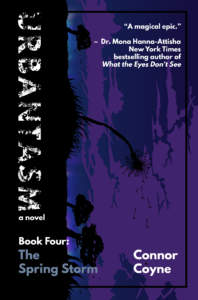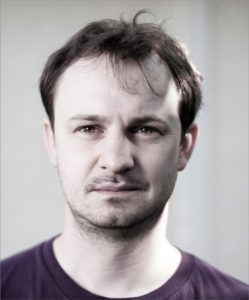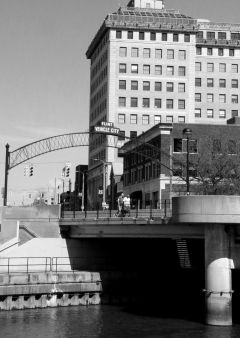By Robert Thomas
The publication of the fourth and final book of Flint author Connor Coyne’s serial novel, URBANTASM, marks the finale of his epic allegory set in the heart of the American Rust Belt in the fictional city of Akawe, Michigan, somewhere north of Detroit.
As befits any gripping serial, The Spring Storm delivers a hammer blow with a rollicking readerly ride through a perfect storm of rusty decay and an abundance of evil.
Having reviewed the first three books for East Village Magazine*, I approached Book Four with anticipatory wonder. How will Coyne pull off this final caper? What will happen to Akawe, the dying city? What will happen to the characters I have come to know and appreciate? What becomes of the mysterious urbantasms, the blue ghosts that inhabit this novel? And what becomes of the fable’s narrator, John Bridge, who opened Book One, The Dying City, with this quest: “I have to become the Antichrist.” Upon listing several grudges against God, he concludes: “If I wanted to save my friends, I would have to kill God.”

Urbantasm – a novel. Book Four: The Spring Storm by Connor Coyne.
How does that work out during The Spring Storm?
The book opens with John standing backstage awaiting a rehearsal for a school play, staring into the stage’s single ghost light, a single bulb illuminating an unlit stage while he thinks about the breathless days that had passed.
Nobody knew why they called it the “ghost light,” John Bridge says. I thought it was because of the way the space felt. An ephemeral glow surrounded by the predatory darkness. Yet better than the darkness alone.
As with first book, The Spring Storm opens with a horrific murder in which one cousin kills another with a hatchet. The blue ghostly urbantasms return to haunt the scene. Also, John’s friend Selby—she who told John about urbantasms—mysteriously disappears. She leaves a note for John:
Remember when we ran barefoot through the snow? Like I said we needed to get out. I see things different now. I’ll see God in Hell. Right now I want to find who is trapped in heaven. I might be gone for awile (sic).
John’s opening quest in Book Four is to find Selby. Quanla, a mutual friend of John and Selby, tells John a story Selby told her about the Road of Enoch.
It’s a road that you can take to get to heaven. Like, it was the only way you can get to heaven without dying first. I mean, that’s what Selby said. You have to follow the Road through more than 500 cities, and it’s hidden because good people aren’t supposed to get into heaven until they die, and bad people aren’t supposed to get in at all.
Selby also told Quanla that Akawe was one of the cities along the Road.
As with the previous books, a nightwalk through the dark streets of decaying Akawe is a key ingredient as John follows Selby’s trail down the Road of Enoch, the road to heaven to God’s house in Eden. John describes it:
Of all the nightwalks I have ever taken, this one felt the most dreadful and sublime.
It was like I walked down the barrel of an invisible telescope, an expanding tunnel, a great hallow darkness that pulled the terrible destination away from me even as I approached, so that the exhausting walk might become endless and annihilating.
I knew the way was narrow and straight, so I kept my sunglasses on and my eyes shut. I imagined my feet kicking up blue sparks with every step so that I could bring some substance to to this interminable passage. I tingled in the presence of something shifting through my sunglasses and eyelids, so I lifted them up both. Were those urbantasms or neutrinos – fleeting things – glowing blue? Unilluminated.
I saw nothing.
But while my eyes were momentarily open, quiet lightning flashed behind me. Then I saw what I sought.
What John saw was the house of God along the Road of Enoch in Akawe on Eden Street. The lightning was a portent of an approaching spring storm, a huge tornado that strikes while John is in the house of God, the Empyrean, on Eden Street, with God Ostyn. God not only has a last name, but several aliases—not unlike all forms of human deifications. God or not, Ostyn heads a clan of human predators. He is a deified bad dude who promotes a mysterious drug, O-Sugar, and commands the Os neighborhood in Akawe as well as global properties along the Road of Enoch.
The storm is a maelstrom of shifting shapes in which characters, blue ghosts, and even critters intertwine in a surrealistic swirl of Coyne’s deft prose. The urbantasms rise up to become full-throated characters complete with visuals, sound, and guidance—no longer ethereal blue ghosts or hapless critters riding a rock around the sun. They are on stage and free to play the roles. Real characters are authentic. Coyne’s portrayals sold me on suspending my beliefs and rolling along with his flow, right through the storm and into the aftermath.

Author Connor Coyne. (Photo provided by Connor Coyne.)
The best account of the storm’s mayhem comes from Toussaint, a minor street character in this play. Too long to quote here, but a brilliant breathless moment of jazzy wordplay that concludes with his judgment on the scene:
Nothing will ever be the same here again. In the end we won’t change shit for ourselves, but we will get them to admit it. We will get them to admit. We will get them to admit, from the lowliest city councilman to the President of this D.S.A (Divided States of America), that much is unwell in the land, and that nothing will be the same ever again. Yeah, if nothing else, we will make them abandon t heir charade that it is okay, so call the moths, call the moths, call the moths.
John’s take on the storm echoes Toussaint’s cry.
That night, my nightmares were worse. Before, my memories had been of violence and predation. The predation of humans. The predation of nature. The imperative to move and act and survive….And had I learned anything essential about how to survive the Oystyns? To survive the storm? To survive Akawe? If I had, I must have lost it. The carousel of horrors had obliterated the delicacy of revelation.
As John narrates this tale of woe and wonder, realism and surrealism shape-shift each other. I liken this effect to the transformation that occurs in reality. When an observer enters a new scene, the scene changes existentially.
In the aftermath of the perfect storm of nature and human predation, there are survivors who shape-shift their existential realities. They have survived; now what?
The denouement of Book Four is in the aftermath, in the survivors’ attempts to rise up in various ways from the horrible realities of their very real self-destructive surroundings.
Coyne’s epic allegory is a morality play focused on mortality, not black magic thinking. It is also a grand serial narrative, a giant urbantasm of a serial novel in its own right. What it is not is a dystopic downer tale of tragic proportions. It is a wise universalist fable nimbly narrated.
*Thomas’s previous reviews can be found at the below links:
Reviewer Robert R. Thomas is a former EVM board member, passionately devoted denizen of East Village, and a former San Francisco cable car driver.


You must be logged in to post a comment.